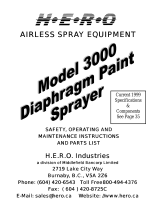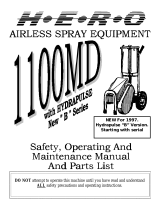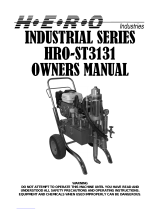HERO 621H Safety And Operating Manual
- Category
- Power fine-spray systems
- Type
- Safety And Operating Manual

FACTORY LOCATED AT:
720 EATON WAY
DELTA, B.C. CANADA
V3M 6J9
U.S.A ADDRESS:
P.O. BOX 75
CUSTER, WASHINGTON
98240-0075
PHONE: (604) 522-6543 FAX: (604) 522-8735 TOLL FREE: (800) 494-4376
SAFETY AND OPERATING MANUAL
Version 5 Dec 2005
www.hero.ca
WARNING: DO NOT OPERATE THIS EQUIPMENT WITHOUT READING
AND UNDERSTANDING ALL SAFETY AND OPERATING INSTRUCTIONS
SEE PAGES 3 – 14

Owner’s Manual Page 1 EC621 / EC725
TABLE OF CONTENTS
PAGE DESCRIPTION PAGE #
Warranty Information 2
Important Safety Precautions 3-4
Introduction and Unpacking 5
Set Up 6
Start Up 7-8
Spray Tip Selection 8-9
Spray Painting Suggestions 10-11
Pressure Relief, Shut Down and Cleaning 12-13
Filter Maintenance 14
Digital Display Troubleshooting and Diagnostics 15-16
Pump Troubleshooting 17
Pump Cartridge and Intake Valve Removal 18-19
Intake Valve Service 19
Intake Valve Service (Old Version) 20
Pump Cartridge Disassembly and Service 21
Pump Cartridge Assembly 22
Prime Valve Service 23
Pump and Drive Assembly Parts Breakdown 24
Cart Assembly Parts Breakdown 25
Wiring Schematic 26
Parts List and Descriptions 27-30
Airless Accessories 30
Contact Information 31

Owner’s Manual Page 2 EC621 / EC725
H.E.R.O. WARRANTY
H.E.R.O. Products Group, guarantees this airless pump to be free of defects in materials and
workmanship to the original owner, for a period of two (2) full years from the date of purchase.
The warranty entitles the owner to parts replacement at no charge. The parts replacement
warranty is valid for any necessary replacement, weather caused by material or workmanship
defect or simple wear. H.E.R.O. Industries offers no warranty on the hoses, gun, tip or
accessories, plastic, rubber, other soft goods or motor used in or supplied with the H.E.R.O.
sprayer.
In addition to the general coverage listed above, a lifetime WARRANTY is offered on the Drive
Train components. The drive train components are defined as the items contained within, but not
including, the “Drive Housing”. Drive motor is not included.
Furthermore, this warranty does not cover, damage or wear caused by faulty installation,
abrasion, corrosion, inadequate or improper maintenance, negligence, or accident.
Motor, accessories, etc., which are supplied by other manufacturers and are attached to or
supplied with the H.E.R.O. airless pump, are warranted only to the extent that these parts are
warranted by their respective manufacturers. Warranty claims on these items must be made
directly to such manufacturers or their local authorized service depots.
The warranty is only applicable to the original purchaser and provided the equipment has been
properly used, operated and maintained in accordance with all instructions, precautions and
warnings contained in this manual. For the purpose of this warranty, damage resulting from
accident, abuse, improper cleaning, storage, fire, flood, or Act of God, is not covered.
H.E.R.O.’s liability is limited to replacing parts found to be defective or worn and does not include;
transportation costs, damage or other expenses of any kind incurred in connection with the
purchase and use of this sprayer.
Repairs claimed under warranty must be performed by an authorized H.E.R.O. Service Center,
using only genuine H.E.R.O. parts. Parts required under warranty will be supplied by your local
H.E.R.O. Service Center.
DO NOT return warranty parts to factory without authorization.
To qualify for the warranty, the warranty card (attached to this page) supplied with this H.E.R.O.
airless pump, must be completed with equipment serial number and signed by the purchaser,
and postmarked within ten (10) days of purchase.
WARRANTY

Owner’s Manual Page 3 EC621 / EC725
IMPORTANT
AS WITH ALL MECHANICAL EQUIPMENT, PROPER OPERATING AND MAINTENANCE
PROCEDURES ARE REQUIRED TO KEEP YOUR H.E.R.O. AIRLESS PUMP PERFORMING TO
YOUR SATISFACTION. THE FOLLOWING SAFETY, OPERATING AND MAINTENANCE
INSTRUCTIONS ARE IMPORTANT.
Read and understand this manual completely, especially with regard to all safety precautions. Read
and follow instructions on all warning labels on your equipment. Keep these warning labels clean and
readable at all times. Order new labels from your local distributor or from H.E.R.O. Industries if
needed. This system is capable of producing 3000 psi (spray pressure). To avoid rupture and injury
DO NOT operate this pump with components rated less than 3000 psi working pressure (including but
not limited to spray guns, hose and connections). Before servicing, cleaning or removal of any part,
shut off power and relieve pressure. WARNING
Prior to the use of the sprayer, ensure that the grounded continuity between the gun and the sprayer
is maintained. The hose shall be at least 50 feet in length. All hoses, guns, and accessories shall be
suitable for the maximum pressure ( 3000 PSI ). The gun shall be provided with a “Safety” which
locks the trigger in the “OFF” position. DO NOT point the gun at another person or spray at any part
of exposed skin. If there are any special or unique conditions for this machine, they shall be further
noted and addressed and must be followed. The manufacturer shall not be responsible for any loss,
damages, or injury of any kind or nature whatsoever resulting from the use of equipment other than in
strict compliance with the instructions, cautions and warnings contained in this operating and
instruction manual.
Never place fingers near spray tip of gun. Never point gun toward any part of the body, or that of any
other person. Material issuing from the spray tip is at high pressure. If fingers, or any part of the body
are placed near the tip of the spray gun, it is possible that the spray could break the skin and inject
some of the material. If injury does occur, seek immediate medical attention. Inform the doctor
what fluid was injected, if the injury is of an injection nature. Never treat the situation as a simple
matter. Equipment and chemicals, when used improperly can be dangerous.
IMPORTANT SAFETY PRECAUTIONS
IMPORTANT SAFETY PRECAUTIONS
NEVER place any part of the body in front of the spray tip or aim the gun toward any part of
the body.
NEVER point the gun toward any individual.
NEVER treat any injury as a simple cut. If injury does occur, seek immediate medical atten-
tion. Inform the doctor what fluid was injected.
NEVER allow another person to use the sprayer unless they are thoroughly trained on its op-
eration and have read all safety precautions in this manual and all safety warning labels at-
tached to unit.
NEVER use around children.
NEVER attempt to perform any maintenance or service on any part of the sprayer without first;
1. Shutting the motor switch to OFF.
2. Relieving all pressure in the pump by triggering the gun.
3. Open prime valve to drain.
4. Locking gun trigger in "LOCKED" position, with gun locked closed.
NEVER operate the sprayer without the tip guard complete and in place.
NEVER spray any material in the vicinity of open flame, pilot lights, electrical outlets or any other
source of ignition.
NEVER spray volatile materials with flash points lower than 140 F (60 C).

Owner’s Manual Page 4 EC621 / EC725
NEVER attempt to stop any leakage in the paint line or at any fitting with your hand or any part of your
body. Immediately shut off the unit should leakage occur.
NEVER allow the paint hose to become kinked, or to touch against rough or sharp surfaces.
NEVER operate the unit at pressures higher than the pressure rating of the lowest rated component in
the system, or the factory preset.
NEVER spray in an enclosed area. The spraying area must be well ventilated to safely remove
chemical vapors.
NEVER operate the unit with worn or damaged accessories, or with accessories other than those
supplied by H.E.R.O. Industries, unless the accessories have been first specifically approved in writing
by H.E.R.O. Industries.
NEVER allow the unit to be serviced or repaired anywhere other than an authorized H.E.R.O. Service
Center, or with other than genuine H.E.R.O. parts or components.
NEVER leave unit unattended without first shutting off, triggering the gun to relieve all fluid pressure, and
setting the trigger lock on gun in "LOCKED" position.
ALWAYS follow H.E.R.O. recommendations for operation and safety.
ALWAYS set trigger lock on gun in "LOCKED" position when not in use.
ALWAYS check connections and fittings for tightness before operating the unit.
ALWAYS locate the unit in a well ventilated area a minimum of 25 feet from the spray area.
ALWAYS ground the unit, the paint containers, and the object being sprayed to eliminate static
discharge. Ensure that all these objects remain grounded throughout the entire spraying operation.
ALWAYS use accessories and components approved for at least 3000 psi (working pressure).
ALWAYS use accessories and components only supplied by H.E.R.O. Industries.
ALWAYS examine accessories for wear or damage before operating the unit.
ALWAYS use lowest possible pressure when flushing and cleaning the unit, and hold the gun firmly
against a metal container to reduce the possibility of static discharge .
ALWAYS wear safety glasses when operating the unit.
ALWAYS wear a face filter mask when operating the unit.
ALWAYS :
1. Shut the motor switch to OFF.
2. Relieve all pressure in the pump by triggering the gun away from your body .
3. Open prime valve to drain.
4. Lock gun trigger in "LOCKED" position, before attempting to perform any maintenance or service on any
part of the sprayer.
ALWAYS ensure fire extinguishing equipment is readily available and properly maintained in the spray
area.
ALWAYS observe good housekeeping and keep the spray area free from obstructions.
ALWAYS be aware that certain chemicals may react with aluminum, carbide, or other components in the
pump system. Read the manufacturer's label on all materials to be sprayed, and follow the manufacturer's
recommendations. If in doubt, consult your material supplier.
ALWAYS replace any damaged airless paint hose. A scratched, cut or otherwise damaged outer sheathing
of the paint hose can lead to a rupture. DO NOT attempt to repair a damaged hose.
IMPORTANT SAFETY PRECAUTIONS
WARNING
DO NOT ATTEMPT TO OPERATE THIS MACHINE UNTIL YOU HAVE READ AND UNDERSTOOD ALL
SAFETY PRECAUTIONS AND OPERATING INSTRUCTIONS. EQUIPMENT AND CHEMICALS
WHEN USED IMPROPERLY, CAN BE DANGEROUS.

Owner’s Manual Page 5 EC621 / EC725
INTRODUCTION & UNPACKING
Congratulations on your purchase of a new H.E.R.O. “EC” series airless paint sprayer. We are
sure you will enjoy owning and operating your new sprayer. With H.E.R.O. airless spray equipment
you will enjoy the features and benefits of this airless. You are spraying paint, not air, and the paint
is driven to the painting surface in a clean, fan shaped spray which penetrates all cracks and
corners. To attain these results, you must adjust the pressure as low as possible. We recommend
that you become familiar with your H.E.R.O. unit. Discuss with your dealer the useful accessory
items they do offer - various types of tips, extension poles for hard to reach areas, extra hose, etc.
Use of accessory items is often the difference between a good job and an excellent one !
Your H.E.R.O. airless sprayer has been fully tested and carefully packaged to avoid damage.
It should be carefully examined upon arrival to determine that the unit shows no signs of
freight damage. If any parts are found broken or damaged, immediately contact the
carrier and arrange for an inspection of the concealed damaged. Claims for damage
MUST be made by the CONSIGNEE and not the shipper. The carrier accepts full
responsibility for the safe delivery of merchandise upon pick-up from the shipper.
The unit shipping carton contains:
4-02-40-3PL1
Piston Lube
(8 Ounce Bottle)
Gun/Hose & Tip Packages
Include: 1/4 x 50Ft Hose, Model 300 or
400 Airless Gun, and 517 Spray Tip
EC-2560
Siphon Hose Assembly
(Sled and Cart models)
EC-2600
Siphon Hose Assembly
(High Boy model)
EC-1000
Unitool
(OPTIONAL)

Owner’s Manual Page 6 EC621 / EC725
SET UP
Setting Up:
1. Attach siphon hose assembly to intake valve
by pulling up intake elbow onto intake valve.
2. Lock clip onto intake valve by sliding clip until
it is locked into its designated slot.
3. Connect prime hose to prime hose outlet
making sure that it is wrench tight.
4. Connect airless hose to pump outlet making
sure that it is wrench tight.
5. Connect airless gun to airless hose making
sure that it is wrench tight and slide the trig-
ger safety lock up to lock the trigger closed.
6. Remove spray tip from tip guard. This is done
by twisting the tip until it aligns with the tip
guard opening and then by pulling the tip out
of the housing. The tip guard may have to be
loosened to help remove the spray tip. By
removing the tip this will make flushing out
the storage solution safer and easier.
7. Place siphon tube into one gallon of thinner
or flushing fluid. This will be necessary to
flush storage solution from pump. If using a
highly volatile solvent or paint in a metal con-
tainer it is highly recommended to ground the
container with a grounding wire to ground to
prevent risk of static discharge. If storage so-
lution has been flushed already with thinner,
then sprayer should be flushed with water if
using water base paints or flushed with cor-
rect thinner for oil base paints. Check paint
manufacturer recommendations.
8. Apply packing lubricant. This will help prevent
buildup of materials on the piston rod thus
extending packing life. To add lubricant, in-
sert pointed nozzle of the 3PL liquid into the
slotted area in the front of the unit. Add only a
small amount . This should be done each
time the sprayer is used. Before each use,
flush the pump with the correct thinner for
the paint being used.
NOTE: The unit MUST be stored with mineral
spirits at all times in order to protect pump from
corrosion and extend pump life.

Owner’s Manual Page 7 EC621 / EC725
START UP
Setting Up (Continued):
1. Flip prime valve lever up to open. This is re-
quired to remove air out of the pump.
2. Turn pressure control knob counter clockwise
to lowest set ting. This will cut the power off
until the pressure control knob is turned
clockwise to desired setting.
3. Make sure that the power switch is in the “off”
position and plug the power cord into a 115V,
15 amp., grounded circuit. Note; if using an
extension cord, you must use a #12/3 wire
grounded cord, up to 50 feet or #10/3 wire
grounded cord up to 100 feet. DO NOT EX-
CEED 100 FEET OF EXTENSION CORD. If
distance is greater, purchase and install addi-
tional lengths of airless spray hose.
4. Flip the power switch to the “on” position.
5. Slowly turn the pressure control knob clock-
wise until motor runs.
6. As motor is running with the prime valve
open, the bypass light will be lit to show that
the unit is in prime or “bypass” mode.
7. Allow sufficient time for thinner to circulate
back into the siphon container. It should be
flowing at a constant rate and this may take
seconds to minutes depending on the
viscosity of the paint or flushing fluid.
8. Flip the prime valve lever down to its “closed”
position. The unit should start to build pres-
sure. Check to see if there are any leaks from
any connections. DO NOT attempt to try to
stop any leaks with your hand or with a
rag. If leakage occurs, shut the power switch
to the “off position immediately and flip the
prime valve up to open and release any re-
maining pressure. Tighten and recheck con-
nections on all fittings and repeat from step 1.
If no leaks continue to step 9 on page 7.

Owner’s Manual Page 8 EC621 / EC725
START UP
SPRAY TIP SELECTION
Hero Flip Tips are coded with three (3) numbers.
To determine the fan size:
1. Double the first number (I.E. : 4 x 2 = 8” inch fan width) this is deter-
mined at approximately 12” inches away from the surface.
2. The last two (2) numbers indicate the orifice size in 1/1000 of an inch.
This is very important as it controls the flow, output of the sprayer, and
overall spray quality.
9. The unit should shut off automatically once it reaches its set pres-
sure. At this point keep the pressure set low, between 500 to
1000 psi. The display should now show the pressure and the
spray light should now be lit. This means that the sprayer is under
pressure and ready to spray.
10. Obtain an empty waste container to flush out storage solution.
Unlock gun trigger and trigger into the waste container and
spray until thinner and or paint is flowing out of gun.
11. The storage solution is now flushed from the sprayer and is ready
for spraying. Gun safety trigger should now be locked. If unit has
been flushed previously and paint is ready to spray, then proceed
to step 12. If paint has not been primed though pump then repeat
steps 7 and 8 on set up page and steps 1 to 12 on start up page.
12. Install spray tip into tip guard. If unsure of which spray tip to use,
refer to spray tip selection chart on page 8.
Please read the next following pages for the pressure adjustment,
spray, maintenance, and troubleshooting instructions.

Owner’s Manual Page 9 EC621 / EC725
NOTE: In order to test if a tip is worn, spray a small amount of suitable material on a test surface and
observe the spray pattern produced on the surface. Try to obtain an even elliptical spray pattern by
first adjusting the pressure down, then gradually increasing pressure until full atomization is achieved.
This should result in a crisp spray pattern with sharp edges and even concentration, see diagram
below. If a satisfactory pattern is unattainable ( look for edges to be rounded with heavier
concentration ), then the tip is worn and should be replaced. Other causes of poor spray fan are
insufficient spray pressure and material viscosity ( may requiring thinning ).
Uneven Spray Pattern
Good
Tip Worn
Tip
NOTE: Use of excessively worn tip can result in apparent poor performance of pump.
Different materials require different sizes of tips, and different paint manufactures produce different
qualities of paints. These materials will effect the overall life of the tip. It is very important to choose
and monitor the right spray tip. It is advisable to obtain a spray tip recommendation from the supplier
of the material to be sprayed. The following table is a general guide and will assist in selecting the
optimum tip to use.
TIP SIZE USED TYPICALLY FOR SPRAYING THESE MATE-
RIALS APPROX. GPM Suggested filter (color) Filter Mesh Sizes
.019 Exterior Latex on large unobstructed areas. .47 White or Green Green - 30 Mesh - Extra
Course
.017 Interior Latex, Exterior Latex, Shake Paint, Exterior Flat
Paints. .31 White White - 50 Mesh - Course
.015 Alkyd Flat Enamel, Interior Latex, Semi-Gloss Enamel,
Stains. .23 White or Yellow Yellow - 100 Mesh - Fine
.013 Fine ground Gloss Enamels, and good quality Stains. .18 Yellow Red - 200 Mesh - Extra Fine
.011 Clear Varnishes and Lacquers. .12 Yellow
ORIFICE SIZE
All tips are rated by the size of the orifice or bore size. The bore size is measured in thousandths of an inch
( .017 = 17 thousandths of an inch ). The size of tip required is based on the consistency of the material to
be sprayed. The thicker the paint, the larger the tip size required. Always consult the product label or ask
the paint retailer for the manufacturer's recommendations with regard to proper tip sizes.
FAN WIDTH
Fan width or pattern width is determined by the spray tip's "fan width" classification. This size is measured
in inches, and is determined when spraying 12 inches from the spray surface and the tip of the gun. Vari-
ous methods of noting the fan widths are used by tip manufacturers. Ask your distributor for assistance.
NOTE: Two tips having the same tip size, but different fan widths will deliver the same amount of paint
over a different area (wider or narrower strip).
SPRAY TIP REPLACEMENT
During use, especially with Latex paint, high pressure and material abrasion will cause the orifice to grow
larger. As the orifice grows larger, the fan width grows smaller. Replace tips before they become exces-
sively worn. Worn tips waste paint, cause over spray, and decrease sprayer performance.
NOTE: When using Latex paint, a spray tip will wear at the rate of one size for approximately every 100
gallons of material sprayed.
SPRAY TIP SELECTION – cont.

Owner’s Manual Page 10 EC621 / EC725
AIRLESS SPRAY PAINTING SUGGESTIONS
A good airless spray application is the result of many factors. Surface preparation, which includes cleaning and
degreasing, priming, material compatibility, quality finish product and correct application technique. All are important to
the finished results.
The key to all good applications is a good spray gun technique. Proper application techniques can easily be learned by
using the following simple guidelines. If you are not familiar with the basic spray techniques we recommend that you
study this portion of the manual and practice the techniques shown. Practice your technique on scrap cardboard or old
newspaper until you feel confident.
FOR EXCELLENT RESULTS, READ AND PRACTICE THESE TECHNIQUES
1. Always strain all paint through a H.E.R.O. strainer bag. The most common reason for airless sprayer’s to
malfunction is foreign matter jamming the valves or plugging the tip. Always strain the paint before putting it through
the pump.
2. Always spray at the lowest pressure setting which will provide a uniform spray fan (fig. 1). Adjust pressure
control knob so that paint is completely atomized. Insufficient pressure will result in "tailing". Too much pressure will
result in excess fog and over spray, excess tip wear, and increased sprayer wear and tear.
3. Always spray at right angles to the surface being sprayed (fig. 2). Angling or arcing the nozzle toward the
surface will cause uneven coverage and excessive over spray.
4. Always hold spray gun 11-12 inches from spray surface (fig. 3). Too close and the fan width will be reduced
and material will be applied too heavily which will cause the paint run or sag. Too far from the surface causes
excessive over spray and light coverage (transparent).
5. Always move the gun parallel to the surface being sprayed, at a consistent speed. This avoids uneven
coverage.
6. Always start the spray stroke before triggering the gun and release the trigger before completing the
stroke (fig. 4). This avoids heavy build up of paint at either end of the spray stroke.
7. Always lap your spray pattern by one half (fig. 5). This assures full coverage of the surface being painted.
Poor Good Tailing Good Pattern Fog,
FIG. 1
FIG. 2

Owner’s Manual Page 11 EC621 / EC725
FIG. 3
FIG. 4
FIG. 5
AIRLESS SPRAY PAINTING SUGGESTIONS
When spraying you may encounter a problem with the spray tip plugging up which will either cause
the spray fan to spit, splatter, finger or just shut off completely. The most likely cause is the spray tip
has partially or completely plugged up with foreign debris from the paint.
To fix this problem it is recommended that:
1. The safety lock on the gun trigger should be locked to prevent any mishandling of the gun while
correcting the tip plug. This is done by sliding up the lock tab which is located behind the gun trig-
ger until it is fully engaged and the trigger can no longer be depressed as shown in fig. 6.
2. Twist the spray tip 180° degrees around as shown in fig. 7.
3. The gun should now be triggered away from the spray surface until the spray tip becomes un-
plugged.
4. After the spray tip has been unplugged twist the tip forward 180° degrees.
5. Slide the trigger safety lock down to release the lock to continue spraying.
6. If problem persists check the gun filter and manifold filter and clean or replace if necessary.
FIG. 6 FIG. 7

Owner’s Manual Page 12 EC621 / EC725
PRESSURE RELIEF / SHUT DOWN / CLEANING
When finished spraying or switching to a different
paint, the sprayer will need to be cleaned thor-
oughly. The following steps should help you
through the pressure relief, shut down and/or
cleaning process.
It is very important to read these instructions
as the sprayer will be under high pressure and
if the pressure is not relieved correctly it can
seriously harm or cause injury.
1. Push the gun safety lock up to lock trigger.
This will prevent accidental pulling of the trig-
ger when performing shut down of the
sprayer.
2. Flip the power switch down to the “off” position
to shut power off to the sprayer.
3. Unplug the power cord from the power source.
This should removed by pulling it by the plug
end and not by the cord. This will prevent the
wires in the cord from stretching.
4. Turn the pressure control knob counter clock-
wise to the lowest setting. This will prevent the
sprayer from turning on too soon when the
power is switched on.
5. Obtain a separate waste container and trigger
gun into the container to relieve pressure in
sprayer. This can be done with or without the
spray tip in place.
6. Flip the prime valve up to open and release
any remaining pressure in the sprayer.
7. Place siphon hose assembly into the correct
cleaning solution. If unsure of which solution
to use, refer to the paint manufacturers clean-
ing instructions on the paint container. Hero
Wonder Wash is recommended. This is a
great cleaning solution to clean the pump
when water based paints or stains have been
used.
8. Remove spray tip from gun. This will help to
speed up cleaning the hose and when sprayer
is being cleaned.
Continued on page 12.

Owner’s Manual Page 13 EC621 / EC725
9. Plug the power cord into a 115 volt, 15 amp
grounded circuit. It is very important that
the grounding terminal be place as this will
prevent any static discharge when using hot
solvents.
10. Flip the power switch up to the “on” position.
11. Slowly turn the pressure control knob clock-
wise until motor runs steadily. This will ensure
there is enough rpm for the pump to create suc-
tion.
12. With the prime valve open and the pump
working, the cleaning solution should now start
flowing into the waste container. The bypass
light should be lit to indicate that the sprayer is in
“bypass” mode. This means that the sprayer is
priming.
13. Allow enough time for the cleaning solution to
flow and rinse through the pump section of the
sprayer. This can take several minutes de-
pending on paint or coating in the pump and
siphon hose assembly.
14. Flip prime valve down to close once pump has
had enough time for cleaning solution to rinse
through.
15. Unit should now be building pressure and will
shut off to its setting which is displayed on
digital display. Pressure should be set low,
between 500 to 1000 psi. The spray light
should also be lit on the display which indi-
cates that the sprayer is under pressure and
ready to spray.
16. Unlock gun safety lock on trigger and spray
into a waste container until gun and hose is
thoroughly rinsed with cleaning solution. Lock
gun safety lock on trigger and insert spray tip
back into the tip guard, unlock safety trigger
and trigger once again to clean spray tip.
Once sprayer has been completely rinsed with
cleaning solution, repeat steps 1 to 6 on page
11 to safely relieve pressure from sprayer .
The sprayer’s filters should now be checked,
cleaned or replaced if required. To check the fil-
ters on your sprayer go to page 13.
PRESSURE RELIEF / SHUT DOWN / CLEANING

Owner’s Manual Page 14 EC621 / EC725
FILTER MAINTENANCE
The Hero “EC” series airless sprayers are
equipped with 2 stages of filtration. The first stage
of filtration starts at the siphon hose, which will
help prevent small to large pieces of debris that
would cause damage to the pump, from entering.
The second stage of filtration is an integral filter
manifold. This manifold will help filter out the impu-
rities found in the various paints and coatings. This
second stage of filtration will further filter out these
impurities before reaching the spray gun which will
help the longevity of the spray gun and tip.
Staying on top of proper filter maintenance will
decrease the chance of problems with the pump,
and spray gun and increase the overall longevity of
your sprayer. Both filters are available from your
Hero dealer.
Follow steps 1 to 6 on page 11 to safely
relieve pressure from sprayer before
attempting to check filters.
To check or remove the siphon hose filter, unscrew the filter counter clockwise as shown in
Fig. 1. The filter should be clean and be free of debris, Replace if necessary. It should be
used at all times to prevent unwanted objects from entering and causing damage to the
pump.
To check or remove the manifold filter, unscrew the filter housing counter clockwise as
shown in Fig 2 and Fig 3.
Once the housing has been removed, you will find the filter screen and the filter support
spring. The screen should be cleaned after every use to prevent plugging and or filter col-
lapse. If the filter is not cleanable then it should be replaced.
The standard filter size that comes with your sprayer is “60 mesh” which is good for most wa-
ter and oil based coatings. For higher build paint products, the filter should be changed to a
“30 mesh” filter which would allow the thicker material to more easily flow through the filter.
For fine finish applications when using oil based enamels and lacquers it is recommended
that the filter should be changed to a 100 mesh filter which would better filter out any small
debris before reaching the spray gun and tip. These filters can be ordered through your Hero
dealer.
To reinstall the filter assembly, insert the support spring into the filter screen and insert it into
the pump manifold. Next screw the filter housing clockwise into the pump manifold and hand
tighten until snug.

Owner’s Manual Page 15 EC621 / EC725
DIGITAL DISPLAY DIAGNOSTIC CODES
The Hero “EC” electronic digital display is has a trouble shooting diagnostic program. If you
encounter a problem with the sprayer, read the diagnostic code displayed on your display
and refer to the codes below to determine the problem. If unsure or if you require technical
assistance, call the Hero technical service department for any questions or inquiries.
Error Code Cause Remedy
E001 1. Broken connection on circuit board, can-
not process information.
2. Digital display failure.
1. Turn power off to clear error code. If
problem persists, the circuit board may
need to be replaced.
2. Turn power off to clear error code. If
problem persists, the circuit board may
need to be replaced.
E002 1. Broken display connection to circuit
board.
2. Display malfunction.
1. Turn power off to clear error code. If
problem persists, the circuit board may
need to be replaced.
2. Turn power off to clear error code. If
problem persists, the circuit board may
need to be replaced.
E003 1. LED malfunction. 1. Turn power off to clear error code. If
problem persists, the circuit board may
need to be replaced.
E004 1. Circuit board and circuitry have gotten
too hot. This will occur at 80° Celsius. 1. Make sure that the circuit board is se-
curely fastened to housing in order for
proper cooling to occur.
Check that heat sink compound is in place
to help dissipate heat.
Turn power off to clear error code. If
problem persists, the circuit board may
need to be replaced.
E005 1. Not enough memory in the computer to
record and process the running time of
the sprayer.
1. Only occurs when the sprayer has been
run for more than 5000 hours.
If it reoccurs frequently the circuit board
will need to be replaced in order for time
to be stored again.
The pump can still operate but no time will
be counted. The digital display would only
show the pressure.
Turn power off to clear error code. If
problem persists, the circuit board may
need to be replaced.
E006 1. Computer is having trouble to save and
process information. 1. This is checked every time the time is
stored, about once every six minutes.
Turn power off to clear error code. If
problem persists, the circuit board may
need to be replaced.
E007 1. Computer malfunction. 1. This should never occur normally.
Turn power off to clear error code. If
problem persists, the circuit board may
need to be replaced.

Owner’s Manual Page 16 EC621 / EC725
Error Code Cause Remedy
E008 1. Pressure transducer failure. 1. Make sure that the sensor is plugged in
and that no wires are broken.
Turn power off to clear error code. If
problem persists, the sensor should be
then replaced.
E009 1. Incoming voltage is too high. 1. This will occur if the incoming voltage
increases to 160 volts AC.
The error code will be cleared once
automatically once the voltage come back
down.
Turn power off to clear error code.
E010 1. Incoming voltage too is low. 1. This will occur if the incoming voltage
drops to 95 volts AC.
The quality, condition, length of the power
cord are extremely important. Heavy
gauge extension cords are always re-
quired for proper and efficient operation of
the electronics on the sprayer.
The error code will be cleared once
automatically once the voltage come back
down.
Turn power off to clear error code.
E011 1. Current draw limit protection has been
reached. 1. This is used to protect the motor windings.
The fuses, circuit breaker, thermal switch,
and the temperature sensor will handle
any long term over-current issues.
EEEE 1. Unknown error has occurred. 1. This should never occur in normal use.
This would imply a malfunction of the
computer itself.
Turn power off to clear error code. If
problem persists, the circuit board may
need to be replaced.
DIGITAL DISPLAY TROUBLE SHOOTING

Owner’s Manual Page 17 EC621 / EC725
PUMP TROUBLESHOOTING
TROUBLE POSSIBLE CAUSE REMEDY
Motor will not
start or run
1. Unit unplugged.
2. Unit not switched “ON”
3. Pressure control knob is set too low.
4. Pump at full pressure.
5. Blown fuses on circuit board.
1. Plug unit in to a 120V, 60HZ,
2. Flip On/Off switch to ON
3. Slowly turn knob until motor runs and follow
start up instructions.
4. Follow “pressure relief instructions”
5. Check and or replace fuses on the circuit
Motor runs but
has poor unit
performance.
1. Stuck ball in pump section.
2. Worn spray tip.
3. Improper tip size.
4. Material too viscous (thick).
1. See fluid section repairs.
2. Replace tip.
3. Check spray tip selection chart.
4. Thin material with appropriate thinners, as per
product manufacturer’s
Low or erratic
output or
pressure
1. Air leaks or blockages.
2. Worn packings, Intake or Outgo
balls and / or seats.
1. Check the following;
►Intake tube fitting.
►Plugged intake screen.
►Intake O-ring.
2. Re-pack pump.
3. Replace piston valve O-Rings.
Unit does not
prime 1. Worn packings.
2. Air leak.
3. Paint level too low.
4. Prime valve plugged.
5. Paint too thick.
1. Re-pack pump.
2. Check the following;
► Intake tube connections.
►Plugged intake screen.
►Intake O-ring.
3. Add paint to pail and re-prime.
4. Disassemble and clean.
5. Thin material with appropriate thinners, per
No output 1. Pump not primed.
2. Pump needs rebuilding.
3. Intake ball stuck to the seat.
1. Prime pump.
2. Rebuild pump.
3. Remove, clean and or replace ball and seat.
Fluid leaks from
front drive
housing.
1. Worn upper packings.
2. Worn piston sleeve and or cylinder.
1. Replace packings with packing kit.
2. Replace if necessary.

Owner’s Manual Page 18 EC621 / EC725
The H.E.R.O. EC units were specifically designed to assist the operator in dealing with the
inconvenient, time consuming, and some times technically challenging concept of equipment service
and repair. The EC models offer simple, quick, easy to perform procedures for all the fluid section
repair procedures. Servicing and the repair of the fluid section can be performed with one simple tool,
the H.E.R.O. “UNI-TOOL™” , ( Part # EC-1000 ). The complete fluid section can be removed and
replaced in about 5 minutes.
REPAIR PROCEDURES
FLUID SECTION
1. Complete “Pressure Relief Procedures” as described on page 4
2. Unplug power cord from electrical source.
3. Remove the siphon assembly (Ref # 1) if a sled or low-boy cart or (Ref #2) if a high boy cart from
intake valve (Ref #24) by pushing the release clip (Ref # 6) over to the side and pulling the siphon
assembly away from the intake valve. NOTE: Bleed hose does not need be removed while
servicing, however you may find it convenient to do so.
4. Using the 1/4” Allan key of your H.E.R.O. Uni-Tool (Part # EC-1000, supplied with each unit),
loosen the four manifold bolts counter clockwise 1/2 a turn as shown in Fig 3.
5. Switch to the 3/8” Allen key and remove the entire Intake valve assembly by turning it counter
clockwise as shown in Fig 4. Continued on page 19.
Tip the entire unit back into a vertical position.
this provides greater access to the fluid section, while making repairs.
EC-2700
EC-1000
Fig 3 Fig 4

Owner’s Manual Page 19 EC621 / EC725
REPAIR PROCEDURES
Fig 5
6. Using the 5/8” socket end, remove the entire pump cartridge assembly by turning it counter
clockwise as shown in Fig 6 until it is fully removed from the connecting rod.
Fig 6
Fig 7
The entire intake section is now removed as shown in
Fig 7, awaiting further repairs or service. Refer to the
various service repairs on the pages to follow. See
below for intake valve disassembly. Pages 20-21 for
piston valve, cylinder, packing kit assembly repairs,
and page 21 for whole piston valve / cylinder / pack-
ing kit assembly replacement and unit re-assembly.
Removal of intake valve
To remove the intake valve assembly follow steps 1 - 5 on page 18.
Once removed from pump manifold, intake valve can now be disassembled. Turn
valve body (Ref # 25) upside down and carefully tap valve onto work surface to
remove components. Inspect all parts for wear or damage.
Assembly of intake valve
1. Install intake crush Washer (Ref # 27) into the Intake Housing (Ref #25).
2. Insert intake seat (Ref # 28) into the intake housing. The intake seat is bev-
eled on both sides, if seat is worn it can then be flipped over and used again.
3. Place the intake ball (Ref # 29) on to the intake seat.
4. Install the Viton (Brown) o-ring (Ref # 26) onto the ball guide (Ref # 30).
5. Lubricate the Viton (Brown) o-ring (Ref # 26) and install ball guide (Ref # 30)
into the intake housing (Ref # 25).
6. Screw the assembled intake valve assembly into the pump manifold.
Simple cleaning and debris removal can be undertaken without dismantling the entire intake
valve
assembly. For component replacement, see disassembly and re-assembly instructions.
INTAKE VALVE ASSEMBLY
Page is loading ...
Page is loading ...
Page is loading ...
Page is loading ...
Page is loading ...
Page is loading ...
Page is loading ...
Page is loading ...
Page is loading ...
Page is loading ...
Page is loading ...
Page is loading ...
Page is loading ...
-
 1
1
-
 2
2
-
 3
3
-
 4
4
-
 5
5
-
 6
6
-
 7
7
-
 8
8
-
 9
9
-
 10
10
-
 11
11
-
 12
12
-
 13
13
-
 14
14
-
 15
15
-
 16
16
-
 17
17
-
 18
18
-
 19
19
-
 20
20
-
 21
21
-
 22
22
-
 23
23
-
 24
24
-
 25
25
-
 26
26
-
 27
27
-
 28
28
-
 29
29
-
 30
30
-
 31
31
-
 32
32
-
 33
33
HERO 621H Safety And Operating Manual
- Category
- Power fine-spray systems
- Type
- Safety And Operating Manual
Ask a question and I''ll find the answer in the document
Finding information in a document is now easier with AI
Related papers
Other documents
-
 I.C.T.C. Holdings Corporation 300S Legend User manual
I.C.T.C. Holdings Corporation 300S Legend User manual
-
 I.C.T.C. Holdings Corporation 1150GSD User manual
I.C.T.C. Holdings Corporation 1150GSD User manual
-
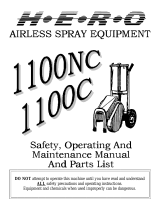 I.C.T.C. Holdings Corporation Airless Spray Equipment User manual
I.C.T.C. Holdings Corporation Airless Spray Equipment User manual
-
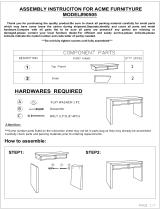 Dorel Home 90505 Assembly Manual
Dorel Home 90505 Assembly Manual
-
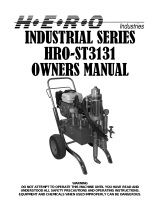 I.C.T.C. Holdings Corporation HRO-ST3131 User manual
I.C.T.C. Holdings Corporation HRO-ST3131 User manual
-
Steelcase Turnstone Elbow Chair Assembly Instructions
-
WAGNER W180P Owner's manual
-
I.C.T.C. Holdings Corporation PW2700-SC User manual
-
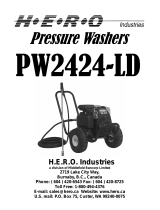 I.C.T.C. Holdings Corporation PW2424-LD PW2424-LD User manual
I.C.T.C. Holdings Corporation PW2424-LD PW2424-LD User manual
-
Solo 0610407-K Owner's manual

































